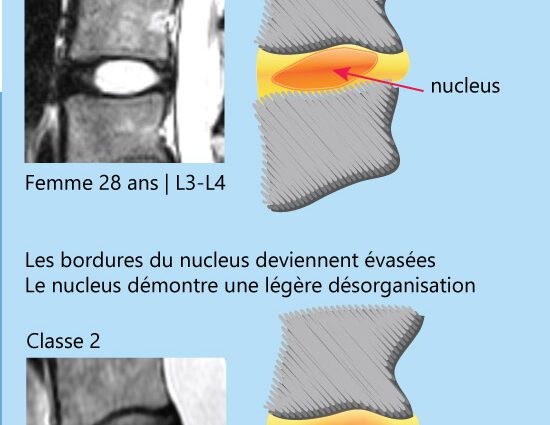Contents
Discarthrose
Discarthrosis, or degenerative disc disease, is defined by the irreparable wear and tear of the discs located between the 24 mobile vertebrae of the spine. With age, the discs become dehydrated, crushed and lose their beneficial roles. Biological age is the main cause of discarthrosis, which begins around the age of 20. But if the discarthrosis is irreversible, there are on the other hand ways to slow down its progression by reducing the pressure exerted on the spine.
What is discarthrosis?
Definition of discarthrosis
Discarthrosis, or degenerative disc disease, is defined by the irreparable wear and tear of the discs located between the 24 mobile vertebrae of the spine.
Each intervertebral disc consists of a fibrous ring (annulus) at the periphery and a gelatinous nucleus (nucleus) at the center. Essential elements of the spine, the discs ensure its movements – flexion, extension, torsion and lateral inclination. They also have a role of shock absorber in the event of impact or high pressure between two vertebrae. With age, the discs become dehydrated, crushed and lose their beneficial roles. We then speak of discarthrosis.
Types de discarthroses
There are three types of discarthrosis:
- The cervical discarthrose;
- Lumbar discarthrosis;
- Staged discarthrosis, which affects several vertebrae at the same time.
Causes of discarthrosis
Biological age is the main and unavoidable cause of discarthrosis.
Diagnosis of dysarthrosis
Magnetic resonance imaging (MRI) of the spine allows the analysis of the condition of the intervertebral discs. Electromyography can also be used to assess the health of muscles and the nerve cells that control them.
People affected by discarthrosis
No one escapes discarthrosis, which begins around the age of 20. In general, men are more prone to discarthrosis than women, but this tendency is reversed after menopause.
Factors favoring discarthrosis
Some factors can promote early discarthrosis:
- A genetic predisposition;
- Congenital anomalies of the spine;
- Repeated trauma, shocks or compression forces (great athletes);
- Overweight;
- Lack of physical activity;
- Bad postures and incorrect movements;
- Smoking.
Symptoms of discarthrosis
No symptoms
In its early stages, discarthrosis does not always cause pain, which does not mean that it is not already on.
Neck pain and stiffness
Cervical discarthrosis is responsible for pain and stiffness in the neck.
Chronic lower back pain
Lumbar discarthrosis frequently affects the fourth or fifth lumbar vertebra and the first sacral vertebra. It is one of the main causes of chronic pain in the lower back.
Neuralgic pains
Vertebrae with discarthrosis can move and pinch one of the roots of a nerve. The pain is then intense and radiates into the arms, back and shoulders for cervical discarthrosis and in the buttock, thigh, calf and foot for lumbar discarthrosis.
Treatments for discarthrosis
The main focus of treatment for discarthrosis is to reduce its progression and relieve pain. It is based on:
- Physiotherapy by maintaining and improving the mobility of the spine, combined with advice on back hygiene in order to limit the constraints applied to the spine;
- Analgesic, anti-inflammatory and muscle relaxant drugs, which can help reduce pain.
Surgery, performed as a last resort, makes it possible to replace a very damaged disc (arthroplasty), to weld two vertebrae together (arthrodesis) or to loosen a nerve.
Prevent discarthrosis
If the discarthrosis is irreversible, there are on the other hand ways to slow down its progression by reducing the pressure exerted on the spine and therefore on the discs:
- Decrease sitting time;
- While seated, take frequent breaks and change positions;
- Strengthen your back;
- Avoid overweight to relieve the spine;
- Stay hydrated;
- Eliminate aggravating factors such as vibrations or recurring shocks.










